
Most of us as teenagers started writing in a diary as a safe space for inner thoughts and feelings hidden from the outside world. Diaries hold such a special power as one’s secret possession keeping a person’s truest and most vulnerable emotions. Once in college, diaries remain where to write and conceal a secret crush on the brown-haired friend who sits in front in College Algebra class. Sometimes, one expresses how lonely it feels to be far away from home. The blank pages provide a sanctuary where the paper becomes your loyal company by preserving the unfiltered whispers of the heart and mind too delicate to share with the outside world. Would you write as much and in such detail in your diary if you feared it found? Would you write even more often and explain every thought, if you knew it could teach the entire world about the worst tragedy you were about to live through becoming your only legacy?
Now imagine your untimely death could mean your diary would be published, all your deepest desires and unspoken truths exposed for the world to read, to judge, or to criticize. Your diary now famous worldwide classified as one of the most powerful autobiographies in classic World War II literature. This is exactly what happened to the diary of Anne Frank! She was thirteen years old when she first started writing her diary, what would soon become far from your typical teenage diary. She chronicled not only a very important period of Second World War but did so while living with her family in fear for their lives each day, hiding from the Nazis. Yet, Anne Frank’s account of her daily life and family situation became so much more. During the period of her writing, she endured the most horrific part of history the world had yet encountered, the systematic elimination of Jews and other groups targeted by Nazis during the Holocaust. Let me first quickly explain how her diary ended up published as skillfully revealed through Daniela Cardonas’ article A Father’s Love: the Publication of the Diary of Anne Frank.1
It was the summer of 1945, Otto Frank had just returned back to Amsterdam after the war where news about the death of his two daughters and of his wife awaited him. His heart shattered, Otto needed to find a way forward. A family friend, Miep Gies, who had helped the Franks during their time in hiding, had kept Anne’s diary safe through the years. She gave Otto what would become his most precious possession. She handed him a red plaid covered notebook, his daughter’s diary.2

Initially, Otto was overwhelmed with grief and could not bear to read Anne’s diary. The pain of her absence was too much for him to bear. Yet, Otto felt more and more drawn to Anne’s diary. His intrusive thoughts were haunting him with a sense of urgency to know his daughter more intimately. He knew once he opened his daughter’s world it would never be the same. With Otto’s difficult decision of respecting his daughter’s privacy or making his daughter’s dreams a reality. Immediately, he opened her diary, with no time left to think. His hands quivering as he turned the pages discovering Anne’s colorful soul and the depth of her thoughts. He became captivated with her writing. Could reading it over help him make sense of the unending loss he faced? Would Anne have ever wanted her father to read it? Could God give him back a little piece of his daughter? Could reliving moments when he was hiding with his family help keep them alive even if only in his memory? Was this Anne’s chance to become a writer and defy Nazi cruelty and and her own death? He must have agonized over these thoughts and so many more in the first few days with the diary likely were, he made a choice. Otto began sending paragraphs of Anne’s diaries to loved ones. He then sought to publish her diaries.3 Yet, publishing Anne Frank’s Diary was not easy. Rejections came often. Regardless of these inconveniences, Otto, her father, was now the key to making Anne’s dream of being a renowned writer come true. To learn more about Anne Frank’s Diary publication, I highly recommend reading Daniela Cardona’s to fully grasp and understand the true emotion behind this.4
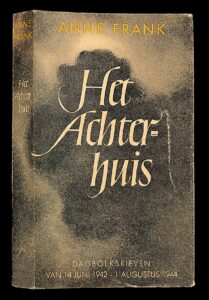
The Diary of Anne Frank was first published on June 25, 1947, in Dutch with an edition of 3,036 copies paving the path to a world changing story. Following the success of the Dutch edition, Anne’s diary caught the eyes of publishers, one in West Germany and one in France. In 1950, her diary was translated in both languages and published during the same year. Initially the first German edition was not entirely a success. Until Das Tagebuch der Anne Frank was published as a cheap pocket in 1955.5 This was the turning point for Anne Frank’s Diary. Due to the play’s popularity and massive success, 700,000 copies of Anne Frank’s Diary were printed. Anne’s diary popularity even reached East Germany where it led to its’ publication as well. When the French edition was released, it received nothing but positive reviews. Meyer Levin, an American author, who becomes decisive in lauding her talent and helping her reach the English speaking world, was the first to write about the Het Achterhuis (The secret annex in Dutch) where he refers to Anne as a ‘highly gifted writer’ in the “Congress Weekly” magazine.6 Getting the English edition published was the hardest to reach. After five years of rejections, the first copy translated to English was released in the Netherlands with an edition of 5,000 copies. Yet, behind closed doors no one knew that Meyer Levin and Otto Frank were in an informal partnership. Due to his obsession with Anne’s diary, Levin helped Otto Frank secure a publishing contract with Doubleday in the Netherlands. Sales were slow. Shortly after, Meyer Levin wrote a review about Anne Frank’s Diary in The New York Times Book Review, without disclosing his vested interest in the book’s performance. This review changed everything for ever. All 5,000 copies were sold out and 15,000 more copies were ordered for the second edition. Then within days, 45,000 copies were in demand for the third printing. Not long after, Broadway and Hollywood expressed interest, Levin wanted to take Anne’s story on screen and stage with permission to adapt Anne’s diary. Eventually, this arose problems resulting in Levin suing Otto Frank for violating his artistic freedoms over Anne’s diary on stage since Otto refused to allow Levin’s version to be focused towards a dead jewish girl’s diary and not what her diary is intended to resemble.7
Like Otto Frank once said, “Anne’s book is not a war book. War is the background. It is not a Jewish book either, though Jewish sphere, sentiment, and surrounding is the background” (54).8 Anne Frank’s Diary reached millions of Americans drastically. Now Anne Frank’s Diary has been translated into more than 70 languages and has sold more than 30 million copies making her globally famous.9
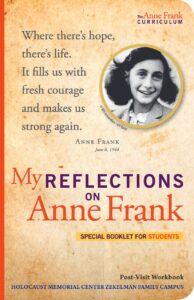
Thanks to the publication of Anne Frank’s Diary. Schools all around the world started including Anne Frank’s Diary in their teachings about the Holocaust since the late 1970s. Many schools required her diary as well as additional textbooks for many history courses. Anne Frank has been part of our school curriculum for decades under Holocaust or genocide education but has never been named after one. Until 2013, when The Anne Frank’s Curriculum was first introduced and remains active till this day.10 The Anne Frank Curriculum was created to work as a guide to aid teachers when introducing the Holocaust to students. Students will now have a fundamental concept of the Holocaust through Anne Frank’s Diary. Through The Anne Frank Curriculum students will expand on different themes that were inspired by the Diary of Anne Frank. This curriculum is composed of four steps. The first step, Contents and Guidelines for Educators, introduces the curriculum to educators ensuring they have an understanding of the Holocaust, and additionally providing them with recommended readings and resources to maximize students educational experience. The second step, Post-Visit Teacher’s Guide, helps teachers integrate The Diary of Anne Frank by connecting it with the Holocaust which will broaden student understanding of the historical context and let’s them grapple with the human impact of the Holocaust. The third step, Student Handouts are based on having class activities which will encourage and challenge students to learn from one another.
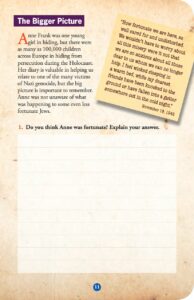
Lastly, the fourth step, Student Workbook, where students are provided questions, activities, and quotes from her diary. With the workbook, students will now be able to put names to faces by being able to identify all the individuals hiding with Anne and her family in the Secret Annex, and will be able to see for the Secret Annex through a model displayed in the workbook. Students will begin to reflect on their own about Anne’s diary, here students will have the chance to express their thoughts, feelings, frustrations, or questions they might have while learning about Anne’s story. Through Anne Frank’s words, students are able to obtain perspective towards important concepts such as: discrimination, humility, love, resilience, hope, faith, genocide, racism, equality, World War II, human rights, and The Holocaust. Anne Frank’s Diary does more than tell a story for students, it illustrates first hand the struggles people endured during World War II. Allowing students to vividly grasp the tragedy of genocide that Jews encountered, that number and statistics alone cannot capture.11
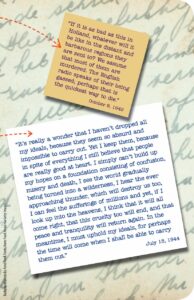
While her story gives us great insight regarding our history as to what Jewish families endured while in hiding , it is so much more than history. Through her writing Anne shows resilience. Anne never gave up fighting for love or hope. Her continuous optimistic view towards the world is what inspired many, despite her circumstances. Even after she was discriminated against for her ethnicity, forced into hiding with two other families, and her constantly living in fear for two years, fear of being being caught and killed. Anne Frank maintained her humanity. Saw goodness beyond all evil. Thus, Anne Frank’s Curriculum aims to not only educate students but to inspire students. For when students read Anne’s story, for them to feel a sense of inspiration to see the good in all evil.12 like she did.
Anne Frank’s Diary serves as a testimony standing against the violation of human rights. She became an international muse to activities all across the world towards social justice.13 Her story allowed the world to see the evil that happened during the Holocaust. Therefore, on December 10,1948, the United Nations adopted the Universal Declaration of Human Rights in response to Nazi’s crimes during the Holocaust.14 This document works as a global blueprint to ensure that all individuals’ rights and freedoms are protected. Guaranteeing all people their rights and freedoms. Without any sort of discrimination. People have the freedom of equality, religion, education, and work. No one must be discriminated against based on their ethnicity, origin, or race. Yet, the Universal Declaration of Human Rights is not always followed.15 Antisemitism is occurring around the world today being displayed as marginalizing, assaulting, or discriminating.16 Anne Frank spent two years hiding in fear vividly illustrating the danger of antisemitism. Numerous individuals are encountering these issues daily, so we must start fighting for our equality. Let’s use Anne Frank as an icon to resemble tolerance and awareness. Thanks to Anne Frank now we are able to spread awareness and start advocating tolerance across the globe by encouraging others to think about the dangers of antisemitism, racism, and discrimination and emphasizing the importance of freedom, equality, and democracy.17 With her story, I believe we are able to touch many more generations’ hearts to come. So I encourage you to read or re-read The Diary of Anne Frank! By reading her words, private thoughts, daily accounts of her life in hiding, and the continuous fear of being caught, we can help honor her memory.
- D. Cardona, (2018). A father’s love: the publication of the diary of Anne Frank. StMU Research Scholars. Retrieved March 25, 2024, from https://stmuscholars.org/a-fathers-love-the-publication-of-the-diary-of-anne-frank/#marker-84482-4. ↵
- United States Holocaust Memorial Museum. (n.d.). Otto Frank. Americans and the Holocaust. Retrieved March 25, 2024, from https://exhibitions.ushmm.org/americans-and-the-holocaust/personal-story/otto-frank. ↵
- Anne Frank Stichting. Otto Frank. Anne Frank House. Retrieved March 25, 2024, from https://www.annefrank.org/en/anne-frank/main-characters/otto-frank/#source-645321. ↵
- Festival De Cannes. Antisemitism. Where is Anne Frank feature animation. Retrieved March 25, 2024, from https://www.whereisannefrank.com/en/about-anne-frank/antisemitism. ↵
- Anne Frank Stichting. How did Anne’s diary become so famous? Anne Frank House. Retrieved March 25, 2024, from https://www.annefrank.org/en/anne-frank/who-was-anne-frank/?gad_source=1&gclid=Cj0KCQjw-_mvBhDwARIsAA-Q0Q5fawujEDpQWGtmlWtFIpu_OuwwHcpFnYTPAIdABNP6SiAuzuCUym0aAs0SEALw_wcB. ↵
- Anuja, N. (2020). Anne Frank: a 15-year-old who told the world what it was like to live during the holocaust. Reader’s Digest. Retrieved March 25, 2024, from https://www.readersdigest.in/features/story-anne-frank-a-15-year-old-who-told-the-world-what-it-was-like-to-live-during-the-holocaust-125988. ↵
- Sorby, A. (2018). Review of an obsession with Anne Frank: Meyer Levin and the diary by Lawrence Graver. (2018). e-Publications@Marquette. Retrieved April 4, 2024, from https://epublications.marquette.edu/cgi/viewcontent.cgi?article=1432&context=english_fac . ↵
- KAVON, E. (2023). Otto Frank and Anne’s jewish legacy – opinion. The Jerusalem Post. Retrieved April 4, 2024, from https://www.jpost.com/opinion/article-747143 . ↵
- Perry, G. W. (2019). About Anne Frank. Anne Frank Center. Retrieved March 25, 2024, from https://annefrank.com/about-afc/about-anne-frank/. ↵
- The Zekelman Holocaust Center. (2013). Anne Frank curriculum. The Zekelman Holocaust Center. Retrieved March 25, 2024, from https://www.holocaustcenter.org/education/anne-frank-curriculum/. ↵
- Landfried, J. (2002). Anne Frank: controversy in education. UCSB Holocaust Oral History Project homepage. Retrieved March 25, 2024, from https://holocaust.projects.history.ucsb.edu/Research/AnneFrank/AnneF20pFinalHM.htm. ↵
- Anne Frank Stichting. The main characters | Anne Frank house. Anne Frank House. Retrieved March 25, 2024, from https://www.annefrank.org/en/anne-frank/main-characters/. ↵
- Blakemore, E. (2019). How Anne Frank’s private diary became an international sensation. HISTORY. Retrieved March 25, 2024, from https://www.history.com/news/anne-frank-diary-symbol-holocaust. ↵
- Shandler, J. (n.d.). Anne, from diarist to icon. Anne Frank House. Retrieved March 25, 2024, from https://www.annefrank.org/en/anne-frank/go-in-depth/anne-diarist-icon/. ↵
- Anne Frank Stichting. The UN adopts the universal declaration of human rights. Anne Frank House. Retrieved March 25, 2024, from https://www.annefrank.org/en/timeline/135/the-un-adopts-the-universal-declaration-of-human-rights/. ↵
- Festival De Cannes. Antisemitism. Where is Anne Frank feature animation. Retrieved March 25, 2024, from https://www.whereisannefrank.com/en/about-anne-frank/antisemitism. ↵
- Anne Frank Stichting. (2021). The Anne Frank house promotes tolerance on UNESCO International Day for Tolerance. Anne Frank House. Retrieved March 25, 2024, from https://www.annefrank.org/en/about-us/news-and-press/news/2021/11/16/international-day-for-tolerance/. ↵


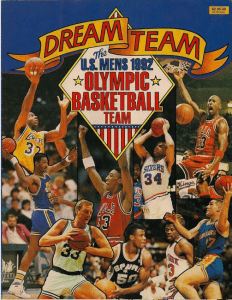

5 comments
Silvia Benavides
Wonderful article! I agree that more research and awareness should be brought up for discussion over Anne Frank.
Leaya Valdez
This was a really amazing article to read and gather information from. As someone who has heard of Ann frank and about her diary but never took time to fully understand it all this article really made me understand why it’s such an important topic to discuss. This article really had me understand the hardship of being a young girl fearing war and death that i feel can be a story many generations should read about.
Ana Barrientos
Hi, Maria! Your title caught my attention and I wanted to read it. I’m so glad I did, I love the introduction. It was personal to so many because many people do have diaries. I liked how you smoothly transitioned to Anne’s Frank’s story, so many people know her name but not her story. I enjoyed how you told her story.
Luis Ramirez
The concept of diaries is indeed fascinating. It’s a universal practice, writing down one’s thoughts and experiences, often prompted by a sense of solitude or the need to safeguard secrets. What’s truly remarkable is how these diaries have become windows into the lives of historical figures, offering profound insights into historical eras when cameras and cell phones were just some sort of imagination.
krivera16
Very interesting article! I absolutely like the intro of how you’re talking about how mostly everyone writes in a diary, because it’s true. Most people do tend to write in a diary because they feel lonely or because they have secrets that don’t want anyone to know at that time. I never realized how we have all these historical people that had all of their life details in a diary and that’s how we know about them and how the world was back then before cameras or cell phones.